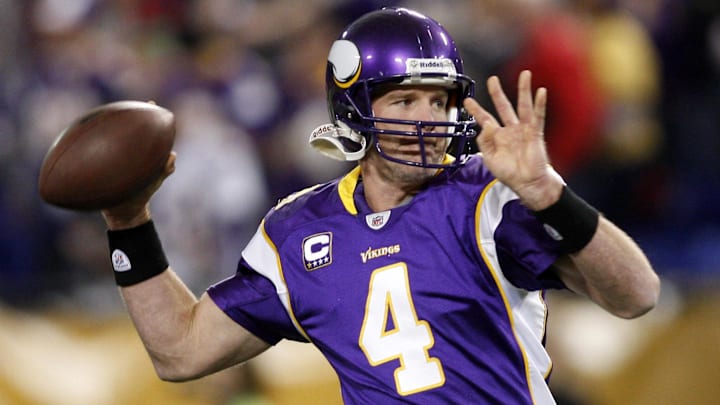When quarterback Daunte Culpepper parted with the Minnesota Vikings following the 2005 season, the team tried desperately to replace him. Between 2006 and 2008, the team drafted Tarvaris Jackson and brought Brad Johnson and Gus Frerotte back for their second stints in the Twin Cities.
The best result was a 10-6 record and wild card playoff loss in 2008. Clearly, if the Vikings hoped to make a deeper run in the playoffs, a significant upgrade at QB was necessary.
In the spring of 2009, Brett Favre was finished in the NFL for the second time. After a long career with the Green Bay Packers, he retired after 2007, then unretired to play for the New York Jets in 2008. His year in the Big Apple started well as the Jets began with an 8-3 record, and Favre looked like he could still bring it.
Then, Favre suddenly proved mortal. Over the final five games of the 2008 campaign, he had two touchdown passes and eight interceptions as New York lost four contests to end with a 9-7 record. It turned out the quarterback had a torn muscle in his throwing shoulder that caused his poor play.
Brett Favre got the call from the Minnesota Vikings 15 years ago
In March 2009, the Jets released Favre, and he, again, announced his retirement. Then Vikings head coach Brad Childress contacted Favre to see if he would be interested in coming back to the NFC North. Only a year prior, the Packers accused Minnesota coaches of tampering in an effort to lure Favre to Minnesota. When he signed with the Jets, the issue abruptly ended.
Favre initially resisted the temptation to return for a 19th season, but he then announced on August 18 that he was unretiring yet again to become a Viking. Suddenly, Minnesota became an instant Super Bowl contender. Favre assured fans that his shoulder was okay, and he was excited to play with the likes of Adrian Peterson, Sidney Rice, and rookie Percy Harvin.
Favre and his new teammates clicked immediately. In Week 4, he met his old team, the Packers and Aaron Rodgers, and led Minnesota to a 30-23 win. Four weeks later, both teams met in Wisconsin, and Favre once again prevailed, 38-26. After the win, the team went into its bye week with a 7-1 record.
Five victories in the last eight weeks took Minnesota to a 12-4 record, the most wins by the organization since 1998. Favre had a fantastic season, finishing with 4,202 passing yards (the third-highest single-season total in his career), 33 touchdowns, and seven interceptions for a paltry 1.3 interception percentage, the best in his career. Those numbers brought Favre his 11th Pro Bowl nod.
In the divisional round, Minnesota pounded Dallas 34-3. Favre had four touchdown passes and the Vikings defense sacked Cowboys quarterback Tony Romo six times. The win set up an NFC Championship date with New Orleans in the Big Easy. This was exactly the reason Minnesota signed Favre.
Meanwhile, the Saints were in the middle of a Cinderella season, flying high at 13-3 with Sean Payton and Drew Brees in the aftermath of Hurricane Katrina. New Orleans was the emotional pick to win the game and get to the franchise’s first Super Bowl. Favre and the Vikings had other ideas.
By halftime, the score was tied at 14 and Favre had hung tough in the face of a Saints defense that looked intent on knocking him from the game. With less than three minutes to play, the Vikings drove to the Saints' 33-yard line and looked to get within range for a possible game-winning field goal. However, two running plays were stopped for no gain, and Minnesota was called for 12 men on the field during a timeout.
The Vikings called a pass play to get the ball back into Ryan Longwell's field goal range. Although he could have run for the first down, Favre threw across his body and the Saints Tracy Porter picked off the ball. That ended the scoring threat and the game went into overtime.
Unfortunately, New Orleans got the ball in the extra period and never gave it up. Garrett Hartley booted a 43-yard field goal through the uprights and the Saints were headed to the Super Bowl. (This game happened one year before the NFL changed its overtime rules that permitted both teams an opportunity for an offensive possession if the first team kicked a field goal).
Months later, Favre returned for his 20th professional season. It did not go as planned. Instead of taking the final step of playing in the Super Bowl, the Vikings went 6-10. Favre was injured in a contest against Buffalo in December and was forced to miss the following week. That ended his consecutive games start streak at 297.
He returned for Week 15 against Chicago and got blasted by Bears defender Corey Wootton. The hit caused a concussion and Favre was sidelined for the remainder of the game as well as the following week’s date with Detroit. That turned out to be the end of Favre’s playing days as he retired for good two weeks later.
